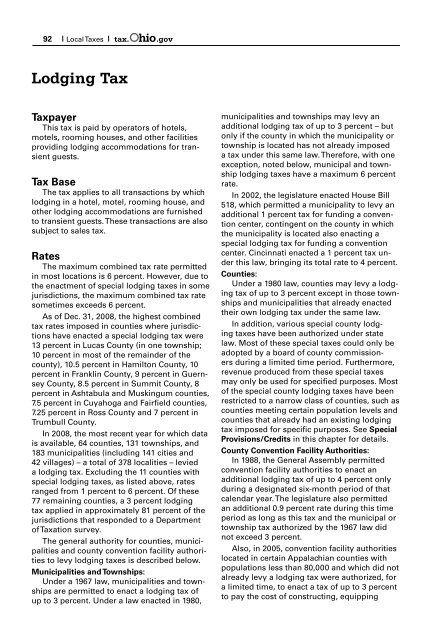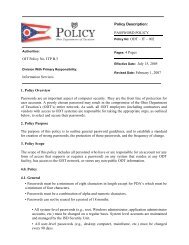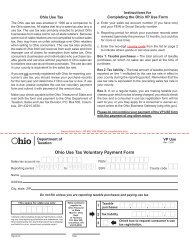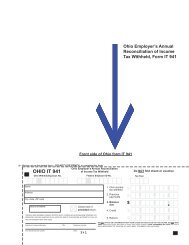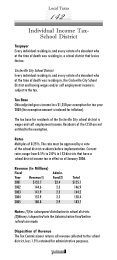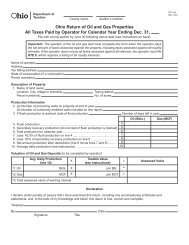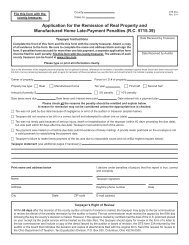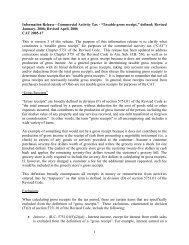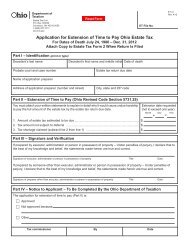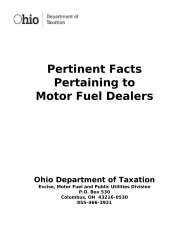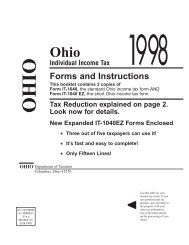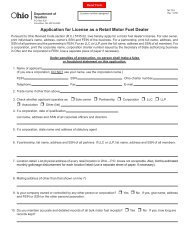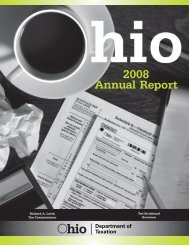Lodging Tax - Ohio Department of Taxation
Lodging Tax - Ohio Department of Taxation
Lodging Tax - Ohio Department of Taxation
Create successful ePaper yourself
Turn your PDF publications into a flip-book with our unique Google optimized e-Paper software.
92<br />
Local <strong>Tax</strong>es<br />
<strong>Lodging</strong> <strong>Tax</strong><br />
tax. hio.gov<br />
<strong>Tax</strong>payer<br />
This tax is paid by operators <strong>of</strong> hotels,<br />
motels, rooming houses, and other facilities<br />
providing lodging accommodations for transient<br />
guests.<br />
<strong>Tax</strong> Base<br />
The tax applies to all transactions by which<br />
lodging in a hotel, motel, rooming house, and<br />
other lodging accommodations are furnished<br />
to transient guests. These transactions are also<br />
subject to sales tax.<br />
Rates<br />
The maximum combined tax rate permitted<br />
in most locations is 6 percent. However, due to<br />
the enactment <strong>of</strong> special lodging taxes in some<br />
jurisdictions, the maximum combined tax rate<br />
sometimes exceeds 6 percent.<br />
As <strong>of</strong> Dec. 31, 2008, the highest combined<br />
tax rates imposed in counties where jurisdictions<br />
have enacted a special lodging tax were<br />
13 percent in Lucas County (in one township;<br />
10 percent in most <strong>of</strong> the remainder <strong>of</strong> the<br />
county), 10.5 percent in Hamilton County, 10<br />
percent in Franklin County, 9 percent in Guernsey<br />
County, 8.5 percent in Summit County, 8<br />
percent in Ashtabula and Muskingum counties,<br />
7.5 percent in Cuyahoga and Fairfi eld counties,<br />
7.25 percent in Ross County and 7 percent in<br />
Trumbull County.<br />
In 2008, the most recent year for which data<br />
is available, 64 counties, 131 townships, and<br />
183 municipalities (including 141 cities and<br />
42 villages) – a total <strong>of</strong> 378 localities – levied<br />
a lodging tax. Excluding the 11 counties with<br />
special lodging taxes, as listed above, rates<br />
ranged from 1 percent to 6 percent. Of these<br />
77 remaining counties, a 3 percent lodging<br />
tax applied in approximately 81 percent <strong>of</strong> the<br />
jurisdictions that responded to a <strong>Department</strong><br />
<strong>of</strong> <strong>Tax</strong>ation survey.<br />
The general authority for counties, municipalities<br />
and county convention facility authorities<br />
to levy lodging taxes is described below.<br />
Municipalities and Townships:<br />
Under a 1967 law, municipalities and townships<br />
are permitted to enact a lodging tax <strong>of</strong><br />
up to 3 percent. Under a law enacted in 1980,<br />
municipalities and townships may levy an<br />
additional lodging tax <strong>of</strong> up to 3 percent – but<br />
only if the county in which the municipality or<br />
township is located has not already imposed<br />
a tax under this same law. Therefore, with one<br />
exception, noted below, municipal and township<br />
lodging taxes have a maximum 6 percent<br />
rate.<br />
In 2002, the legislature enacted House Bill<br />
518, which permitted a municipality to levy an<br />
additional 1 percent tax for funding a convention<br />
center, contingent on the county in which<br />
the municipality is located also enacting a<br />
special lodging tax for funding a convention<br />
center. Cincinnati enacted a 1 percent tax under<br />
this law, bringing its total rate to 4 percent.<br />
Counties:<br />
Under a 1980 law, counties may levy a lodging<br />
tax <strong>of</strong> up to 3 percent except in those townships<br />
and municipalities that already enacted<br />
their own lodging tax under the same law.<br />
In addition, various special county lodging<br />
taxes have been authorized under state<br />
law. Most <strong>of</strong> these special taxes could only be<br />
adopted by a board <strong>of</strong> county commissioners<br />
during a limited time period. Furthermore,<br />
revenue produced from these special taxes<br />
may only be used for specifi ed purposes. Most<br />
<strong>of</strong> the special county lodging taxes have been<br />
restricted to a narrow class <strong>of</strong> counties, such as<br />
counties meeting certain population levels and<br />
counties that already had an existing lodging<br />
tax imposed for specifi c purposes. See Special<br />
Provisions/Credits in this chapter for details.<br />
County Convention Facility Authorities:<br />
In 1988, the General Assembly permitted<br />
convention facility authorities to enact an<br />
additional lodging tax <strong>of</strong> up to 4 percent only<br />
during a designated six-month period <strong>of</strong> that<br />
calendar year. The legislature also permitted<br />
an additional 0.9 percent rate during this time<br />
period as long as this tax and the municipal or<br />
township tax authorized by the 1967 law did<br />
not exceed 3 percent.<br />
Also, in 2005, convention facility authorities<br />
located in certain Appalachian counties with<br />
populations less than 80,000 and which did not<br />
already levy a lodging tax were authorized, for<br />
a limited time, to enact a tax <strong>of</strong> up to 3 percent<br />
to pay the cost <strong>of</strong> constructing, equipping
or operating a convention, entertainment or<br />
sports facility.<br />
Major Exemptions<br />
None.<br />
Revenue<br />
(In Millions)<br />
Calendar<br />
Year Total<br />
2004 $106.1<br />
2005 114.4<br />
2006 122.5<br />
2007 131.7<br />
2008 134.1<br />
Note: These fi gures are as reported by counties, townships, and municipalities<br />
responding to a <strong>Department</strong> <strong>of</strong> <strong>Tax</strong>ation survey.<br />
Disposition <strong>of</strong> Revenue<br />
Under the lodging tax authorized in 1967,<br />
all tax collections are deposited in the general<br />
revenue fund <strong>of</strong> the municipality or township.<br />
Under the lodging tax authorized in 1980,<br />
counties are required to return to municipalities<br />
and townships that do not levy any hotel/<br />
motel tax a uniform percentage (not to exceed<br />
33 1 percent) <strong>of</strong> revenue generated within the<br />
3<br />
municipality and township. The remainder <strong>of</strong><br />
the revenue is to be deposited in a separate<br />
fund to be used for county convention and visitors<br />
bureau expenses.<br />
Municipalities and townships are required<br />
to allocate at least one-half <strong>of</strong> the revenues<br />
from the lodging tax authorized in 1980 for<br />
convention and visitors bureaus located within<br />
the county. Remaining revenues are retained<br />
by the municipality or township and deposited<br />
into the local general revenue fund.<br />
All revenue from a convention facility<br />
authority lodging tax levy is for constructing,<br />
equipping, and operating a convention or<br />
sports center. Revenue from a special county<br />
or municipal lodging tax is to be used for the<br />
purpose designated for that tax levy in state<br />
law.<br />
<strong>Lodging</strong> <strong>Tax</strong> Local <strong>Tax</strong>es<br />
Payment Dates<br />
Monthly or quarterly.<br />
tax. hio.gov<br />
93<br />
Special Provisions/Credits<br />
The General Assembly has authorized the<br />
enactment <strong>of</strong> a lengthy list <strong>of</strong> special lodging<br />
taxes, including in the following counties:<br />
Ashtabula County:<br />
The county enacted an additional 3 percent<br />
tax for constructing or operating a convention<br />
facility during a Sept. 9, 2002 through Sept. 30,<br />
2002 window authorized by House Bill 518.<br />
Cuyahoga County:<br />
The county enacted an additional 1.5 percent<br />
lodging tax for the Rock and Roll Hall <strong>of</strong><br />
Fame 1 during a Dec. 22, 1992 through March<br />
21, 1993 window permitted by the legislature.<br />
Fairfi eld County:<br />
The county enacted an additional 1.5<br />
percent tax for the acquisition, construction<br />
and equipping <strong>of</strong> a municipal educational and<br />
cultural facility during a June 30, 1993 to Sept.<br />
30, 1993 window authorized by the General<br />
Assembly.<br />
Franklin County:<br />
In 1988, Franklin County’s convention facilities<br />
authority enacted a 4 percent levy during a<br />
June 29 through Dec. 31, 1988 window authorized<br />
by the General Assembly. At that time,<br />
Franklin County’s convention facilities authority<br />
also levied an additional 0.9 percent tax<br />
within the city <strong>of</strong> Columbus, which was <strong>of</strong>fset<br />
by a 0.9 percent tax reduction enacted by the<br />
city <strong>of</strong> Columbus.<br />
Guernsey County:<br />
In 1988, Guernsey County’s convention facilities<br />
authority enacted a 3 percent levy during<br />
a June 29 through Dec. 31, 1988 window<br />
authorized by the General Assembly.<br />
Hamilton County:<br />
During a Sept. 6, 2002 through Sept. 30,<br />
2002 window authorized by House Bill 518,<br />
Hamilton County enacted an additional tax<br />
<strong>of</strong> 3.5 percent for constructing or operating a<br />
convention facility. Contingent on Hamilton<br />
County’s action, H.B. 518 permitted the city <strong>of</strong><br />
Cincinnati to enact an additional 1 percent tax<br />
for building or operating a convention facility.<br />
The city did so.<br />
1 Or, per the Revised Code, a “port authority educational and<br />
cultural facility.”
hio<br />
94 Local <strong>Tax</strong>es tax. .gov <strong>Lodging</strong> <strong>Tax</strong><br />
Lucas County:<br />
The county fi rst enacted a special levy <strong>of</strong><br />
3 percent for convention center construction<br />
during a July 15, 1985 to Oct. 15, 1985 window<br />
permitted by the legislature. In 1997, Lucas<br />
County was permitted to enact an additional 2<br />
percent for the county convention and visitors<br />
bureau in promoting the region, and it did so.<br />
In 2006, Lucas County was permitted to enact<br />
an additional 2 percent for purposes including<br />
construction <strong>of</strong> a new arena, and it did so. The<br />
tax is not charged in the city <strong>of</strong> Maumee or in<br />
Jerusalem, Springfi eld or Swanton townships<br />
because these communities were already imposing<br />
a tax at the time this levy was enacted.<br />
Monclova Township later imposed its own<br />
lodging tax in 2007 in addition to the county<br />
tax, making the combined rate in that township<br />
13 percent.<br />
Muskingum County:<br />
In 1988, Muskingum County’s convention facilities<br />
authority enacted a 4 percent levy during<br />
a June 29 through Dec. 31, 1988 window<br />
authorized by the General Assembly.<br />
Ross County:<br />
Ross County’s convention facilities authority<br />
enacted a 1.25 percent levy in 2005, during<br />
a special window authorized for Appalachian<br />
counties with populations less than 80,000<br />
without a convention facilities authority-enacted<br />
tax.<br />
Summit County:<br />
In 1993, the county enacted an additional<br />
1.5 percent tax for the acquisition, construction<br />
and equipping <strong>of</strong> a municipal educational and<br />
cultural facility during a June 30, 1993 to Sept.<br />
30, 1993 window authorized by the General<br />
Assembly. In addition, Summit County passed<br />
an additional 1 percent tax in 2007 for a period<br />
<strong>of</strong> ten years to fund the county convention and<br />
visitor’s bureau.<br />
Trumbull County:<br />
In 2003, the legislature enacted <strong>Ohio</strong> Revised<br />
Code section 5739.09(A)(5), permitting<br />
counties to increase lodging taxes by up to 2<br />
percent in support <strong>of</strong> a “port authority militaryuse<br />
facility.” The following year, Trumbull<br />
County commissioners used this provision to<br />
increase its lodging tax from 2.5 percent to 4<br />
percent.<br />
Sections <strong>of</strong> <strong>Ohio</strong> Revised Code<br />
Sections 307.672, 307.695, 351.021, 505.56,<br />
505.57, 5739.08, and 5739.09.<br />
Responsibility for Administration<br />
County commissioners, township trustees,<br />
legislative authority <strong>of</strong> a municipality, and/or<br />
convention facilities authorities.<br />
History <strong>of</strong> Major Changes<br />
1967 General Assembly authorizes municipalities<br />
and townships to levy a lodging tax <strong>of</strong> up to<br />
3 percent.<br />
1980 Legislature permits counties to levy a lodging<br />
tax <strong>of</strong> up to 3 percent, but only if no<br />
municipality or township located wholly or<br />
partly within the county already enacted a<br />
tax under the same law. Also, municipalities<br />
and townships are authorized to enact an<br />
additional tax <strong>of</strong> up to 3 percent if a<br />
county lodging tax is not in effect.<br />
1994 General Assembly revises 1980 law so that<br />
counties may enact a lodging tax <strong>of</strong> up to 3<br />
percent in those areas <strong>of</strong> the county where<br />
a municipal or township tax had not been<br />
levied under the 1980 law.<br />
2001 House Bill 94 permits counties, cities, villages<br />
and townships to broaden their lodging<br />
taxes to include establishments with<br />
fewer than fi ve rooms. The bill also permits<br />
the assessment <strong>of</strong> penalties and interest for<br />
late payments.<br />
Comparisons with Other States<br />
(As <strong>of</strong> November, 2007)<br />
California<br />
Cities and counties are authorized to levy a<br />
tax on the privilege <strong>of</strong> occupying a room in a<br />
hotel, inn, motel, or other lodging, including<br />
campsites. When levied by a county, the tax is<br />
only applicable to the unincorporated areas <strong>of</strong><br />
the county. The lodging tax is in lieu <strong>of</strong> a sales<br />
tax. In 2007 the maximum rate was 15 percent<br />
(in Anaheim).<br />
Florida<br />
Counties are authorized to enact an array <strong>of</strong><br />
taxes on lodging, including surtaxes on sleeping<br />
arrangements, tourism development taxes,<br />
tourist impact taxes, and convention development<br />
taxes. The maximum rate in effect for any<br />
locality in 2007 was 20 percent, which includes<br />
6 percent in a combined locally-assessed lodging<br />
tax rate and a 6 percent sales and use tax<br />
rate.
Illinois<br />
In general, municipalities and counties can<br />
impose a tax <strong>of</strong> up to 5 percent <strong>of</strong> gross rental<br />
receipts – in addition to the state’s effective<br />
hotel occupancy tax rate <strong>of</strong> 5.64 percent. The<br />
city <strong>of</strong> Chicago imposes the following taxes: a<br />
2.5 percent Metropolitan Pier and Exposition<br />
Authority hotel tax, a 3.5 percent occupancy<br />
tax, a 2 percent sports and a 1 percent municipal<br />
hotel tax. <strong>Lodging</strong> taxes are in lieu <strong>of</strong> a<br />
sales tax.<br />
Indiana<br />
Counties are able to impose a tax on lodging<br />
with a maximum rate <strong>of</strong> 5 percent. However,<br />
counties that pass an innkeeper’s tax may<br />
levy a tax rate greater than 5 percent. Sixtythree<br />
counties levy an innkeeper’s tax. The<br />
lodging tax is in addition to the sales tax.<br />
Kentucky<br />
Local governments may charge a tax on the<br />
rental <strong>of</strong> transient lodging facilities. The rate<br />
may range between 1 percent and 7.5 percent,<br />
depending on location, class <strong>of</strong> government,<br />
and the existence <strong>of</strong> a local tourist and convention<br />
facility. The lodging tax is in addition to the<br />
6 percent sales tax.<br />
Massachusetts<br />
The state imposes a tax <strong>of</strong> 5.7 percent.<br />
Localities have the option <strong>of</strong> imposing an additional<br />
tax <strong>of</strong> up to 4 percent (4.5 percent in<br />
Boston). Some counties levy an additional 2.75<br />
percent convention center fee. <strong>Lodging</strong> taxes<br />
are in lieu <strong>of</strong> the state sales tax.<br />
Michigan<br />
Local governments may impose a tax <strong>of</strong> up<br />
to 5 percent. Convention and tourism bureaus<br />
may enact a tax <strong>of</strong> up to 2 percent in counties<br />
with populations over 1.5 million (meaning,<br />
Detroit’s Wayne County) or up to 4 percent in<br />
counties with populations under 600,000. With<br />
voter approval, eligible municipalities may<br />
enact a tax <strong>of</strong> up to 1 percent to support the<br />
construction <strong>of</strong> stadium or convention center<br />
facilities. A convention facility development tax<br />
with a rate <strong>of</strong> 1.5 percent to 6 percent (determined<br />
based upon population fi gures and the<br />
number <strong>of</strong> rooms in the lodging facility) may<br />
be imposed on accommodations. Both lodging<br />
and sales taxes are assessed on transient lodging;<br />
however, for purposes <strong>of</strong> calculating the<br />
lodging tax, sales taxes are not incorporated<br />
into the taxable base.<br />
New Jersey<br />
New Jersey and its local governments and<br />
local taxing districts assess a variety <strong>of</strong> state<br />
<strong>Lodging</strong> <strong>Tax</strong> Local <strong>Tax</strong>es<br />
tax. hio.gov<br />
95<br />
and local sales taxes, lodging taxes, state<br />
occupancy fee, local occupancy taxes, tourism<br />
assessments, development taxes and<br />
luxury taxes that combined may not exceed 14<br />
percent. The state imposes a 1 percent to 5 percent<br />
state occupancy rate, depending on the<br />
local occupancy tax rate. Municipalities, with<br />
certain exceptions, may enact a municipal occupancy<br />
tax at a rate up to 3 percent. A municipality<br />
in which an international airport terminal<br />
is located may enact a tax <strong>of</strong> up to 6 percent.<br />
Municipalities may also enact a tax, not to<br />
exceed 2 percent, to establish tourism development<br />
tax districts. Tourism lodging taxes <strong>of</strong><br />
up to 1.85 percent may be enacted, as well.<br />
Atlantic City imposes a 9 percent luxury tax<br />
on transient lodging facilities, which combines<br />
with a reduced state sales tax rate <strong>of</strong> 4 percent<br />
and a state occupancy rate <strong>of</strong> 1 percent. Some<br />
counties may levy tourism assessments and<br />
tourism sales taxes. In the Wildwoods areas,<br />
the full state sales tax rate (7 percent) and the<br />
tourism tax (2 percent) are added to a tourism<br />
lodging tax <strong>of</strong> 1.85 percent and a state occupancy<br />
fee <strong>of</strong> 3.15 percent.<br />
New York<br />
Certain counties, cities and villages are<br />
authorized to impose hotel occupancy taxes<br />
ranging from 0.75 percent to 5 percent. Albany<br />
County was authorized to assess a rate <strong>of</strong> 6<br />
percent until Dec. 31, 2008. New York City’s rate<br />
is 5 percent plus an additional tax <strong>of</strong> 50 cents<br />
to $2 based on the daily rental rate plus an<br />
additional fee <strong>of</strong> $1.50 per unit per day. These<br />
taxes are levied in addition to the state’s 4 percent<br />
sales tax and local sales taxes, which may<br />
range up to 5 percent.<br />
<strong>Ohio</strong><br />
In 77 out <strong>of</strong> 88 counties, locally-enacted<br />
rates range up to 6 percent. In the 11 remaining<br />
counties, rates range as high as 13 percent<br />
in parts <strong>of</strong> Lucas County. In <strong>Ohio</strong>, state and<br />
local sales taxes also apply to lodging.<br />
Pennsylvania<br />
The state occupancy tax is collected in lieu<br />
<strong>of</strong> the state sales tax at a rate <strong>of</strong> 6 percent.<br />
Counties other than Philadelphia and Allegheny<br />
are authorized to impose a hotel room<br />
rental tax (maximum rate <strong>of</strong> 5 percent) in<br />
addition to the state occupancy tax. Allegheny<br />
County (Pittsburgh) imposes a 7 percent tax,<br />
while the city <strong>of</strong> Philadelphia assesses an 8<br />
percent hotel tax.
hio<br />
96 Local <strong>Tax</strong>es tax. .gov <strong>Lodging</strong> <strong>Tax</strong><br />
Texas<br />
The state rate, imposed in lieu <strong>of</strong> the sales<br />
tax, is 6 percent. The maximum county rate in<br />
most cases is 7 percent; certain counties may<br />
impose a tax <strong>of</strong> up to 9 percent. A qualifying<br />
municipality may impose a tax <strong>of</strong> up to 9<br />
percent. The cities <strong>of</strong> Houston, Dallas and San<br />
Antonio are exempt from the 9 percent rate<br />
cap.<br />
West Virginia<br />
Cities and counties are able to impose a<br />
tax rate up to 6 percent on hotel rooms. Room<br />
rental is also subject to the state sales and use<br />
tax. There is no state hotel occupancy tax.


